Long, Jean (2011) Update on blood-borne viral infections in injecting drug users. Drugnet Ireland, Issue 37, Spring 2011, pp. 19-21.
| Preview | Title | Contact |
|---|---|---|
|
PDF (Drugnet Ireland, issue 37)
- Published Version
795kB |
HIV surveillance in 2009
Voluntary linked testing for antibodies to HIV has been available in Ireland since 1985. According to the most recent report of the Health Protection Surveillance Centre (HPSC),1 at the end of 2009 there were 5,369 diagnosed HIV cases in Ireland, of which 1,447 (27%) were probably infected through injecting drug use.
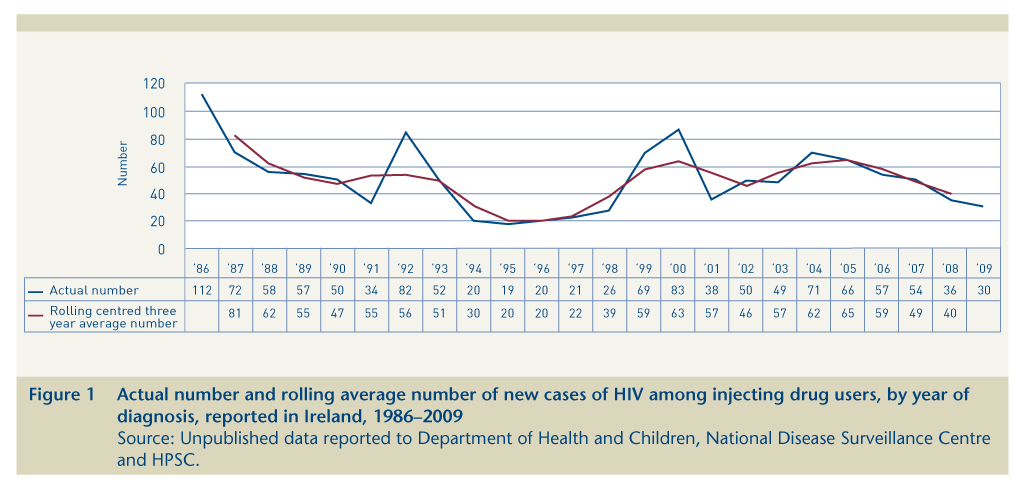
Hepatitis B surveillance in 2009
Hepatitis B is a vaccine-preventable disease which is transmitted through contact with the blood or body fluids of an infected person. The main routes of transmission are mother-to-baby, child-to-child, sexual contact and unsafe injections. The number of cases notified to the HPSC increased in 2007 and 2008, but decreased by 12% in 2009, when it fell from 931 to 820. Of the 820 cases in 2009, 647 had a chronic infection, 78 had an acute infection and the disease status of 95 cases was unknown. The surveillance system has recorded risk factor data since 2004. The percentage of cases notified to the HPSC that included data on risk factors fell from 60% in 2008 to 44% (358 cases) in 2009 (Table 1). Of these 358 cases, ten (2.8%) reported injecting drug use as their main risk factor. The number of cases who reported injecting drug use remained consistently low between 2005 and 2009, indicating the effectiveness of routine administration of the hepatitis B vaccine to such cases.
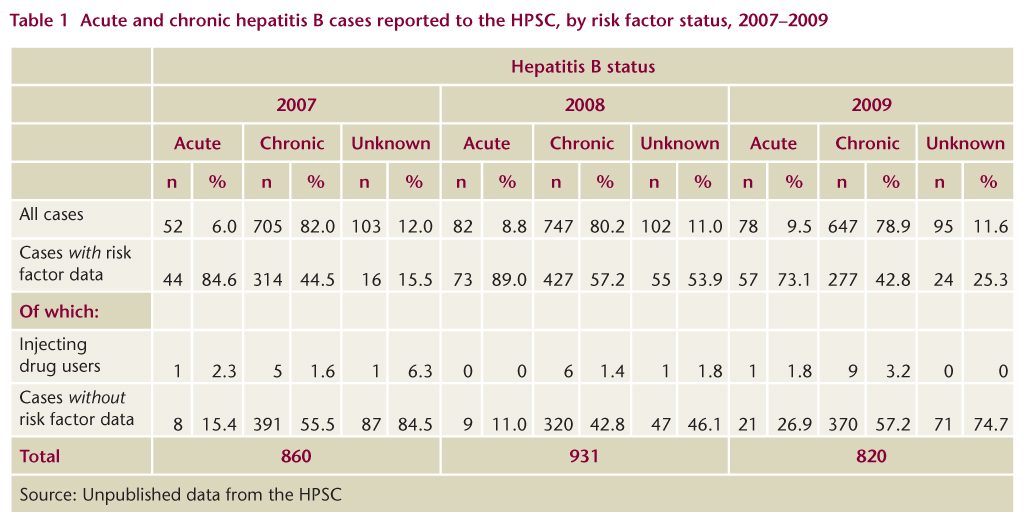
Hepatitis C surveillance in 2009
Hepatitis C is one the most common blood-borne viral infections among injecting drug users and is transmitted through contact with the blood of an infected person. The main routes of transmission are mother-to-baby, unsafe injections, transfusion of blood and blood products, and unsterile tattooing and skin piercing. There were 1,255 cases of hepatitis C reported to the HPSC in 2009 (Table 2), compared to 1,527 cases in 2008.
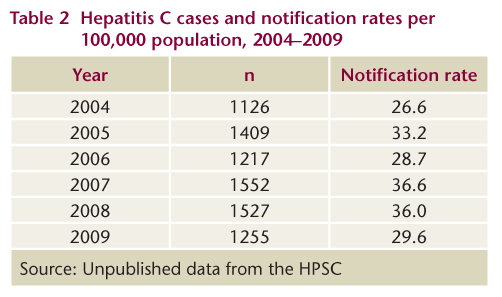
An enhanced surveillance system for hepatitis C was introduced in Ireland in 2007. Enhanced surveillance is essential to identify risk factors and for planning prevention and treatment strategies. In 2009, 40% of newly reported hepatitis C cases had risk factor status reported (Table 3). As expected, the majority of these cases (70.9%) reported injecting drug use as the main risk factor. Four per cent of cases said that they had been recipients of blood or blood products at some time in the past and, according to the HPSC, were late reports to the system (N Murphy, HPSC, personal communication, 2009).
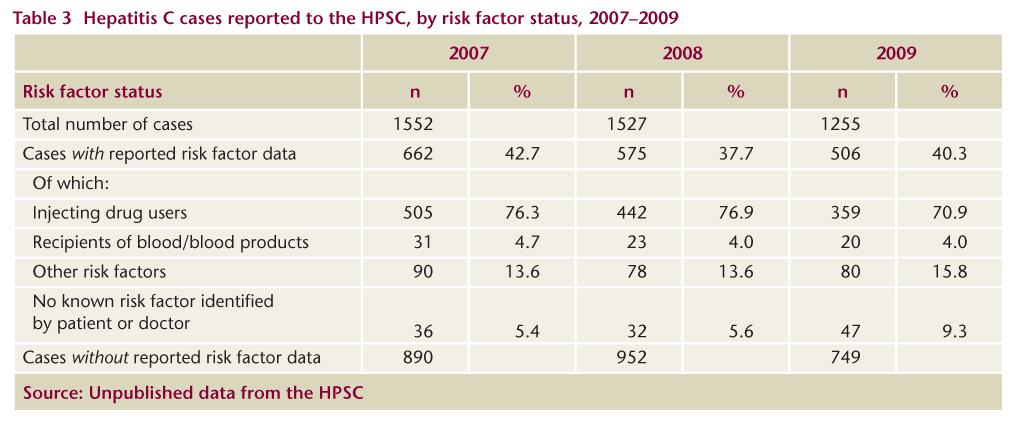
In 2009, 83% of cases reporting injecting drug use as their main risk factor were notified by services in Dublin, Kildare and Wicklow (Table 4). Seventy-three per cent were male and 62% were under 35 years old.
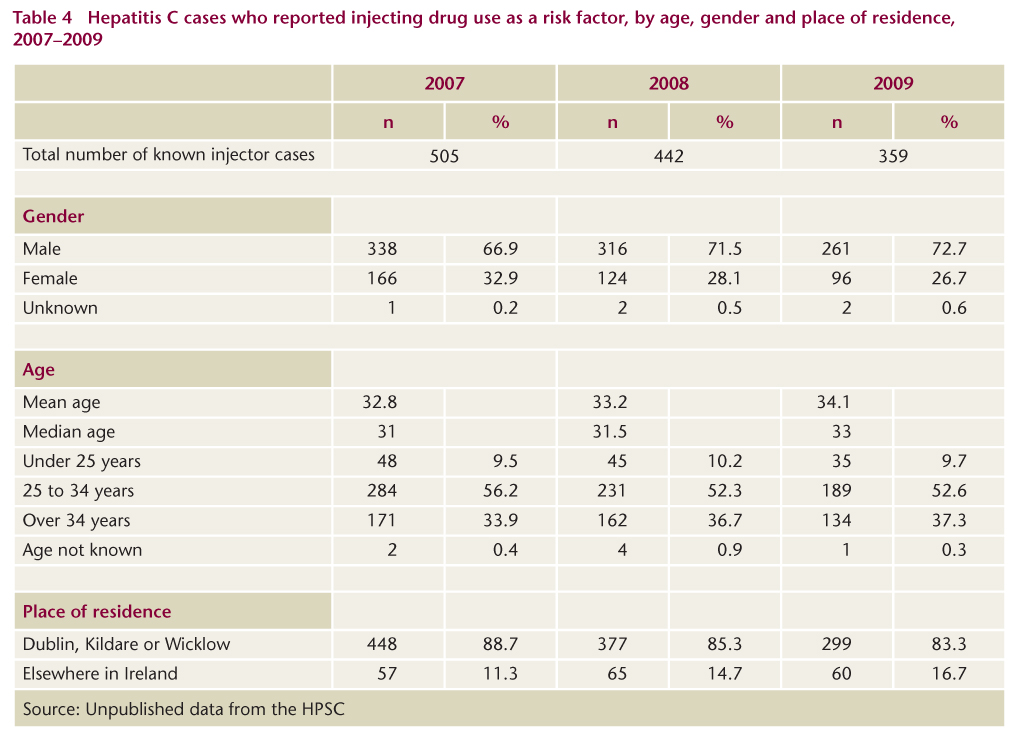
1. Jackson S, O'Donnell K, Moran J and O'Hora A (2010) HIV & AIDS in Ireland 2009. Dublin: Health Protection Surveillance Centre.
G Health and disease > Disease by cause (Aetiology) > Communicable / infectious disease > Viral disease / infection
G Health and disease > Disease by cause (Aetiology) > Communicable / infectious disease > Hepatitis B (HBV)
G Health and disease > Disease by cause (Aetiology) > Communicable / infectious disease > Hepatitis C (HCV)
J Health care, prevention, harm reduction and treatment > Health related issues > Health information and education > Communicable / infectious disease control
T Demographic characteristics > Person who injects drugs (Intravenous / injecting)
VA Geographic area > Europe > Ireland
Repository Staff Only: item control page